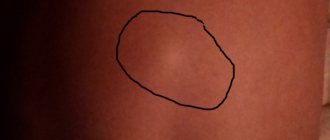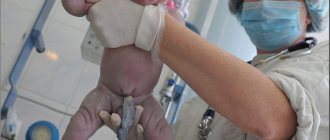What is episiotomy and its types
Episiotomy is a special type of local surgery that involves making an incision in the perineum and posterior vaginal wall.
Today this is one of the most common types of operations. Gynecologists distinguish 4 types of episiotomy:
- mid-lateral view;
- median view;
- lateral view;
- "J" - shaped appearance.
The division into these types occurs according to the location and shape of the section. A midlateral episiotomy involves cutting from the middle of the woman's labia minora diagonally to the left or right.
A midline episiotomy involves cutting the entire perineum down the middle to the anus.
Lateral - the incision is made at an angle of 45° from the center of the perineum.
A J-shaped episiotomy is characterized by an incision that starts from the center of the perineum and resembles the letter J.
Episiotomy can also be divided into:
- one-sided;
- bilateral.
This classification is based on the number and location of seams. Most often, a unilateral episiotomy is used.
The double-sided version is used if it is necessary to apply forceps to the child’s head.
Types of perineal incisions during childbirth
Today, 2 methods of dissection are used, between which there are differences:
- a perineal incision is made along an oblique line towards the ischial tuberosities, the incision height is 2 cm. This type of operation is called episiotomy, and is used quite often;
- a perineal incision in a straight line to the anus - perineotomy. This type of incision is less traumatic, since it does not cut the muscles, but there is a risk that it can continue to the rectum and go to it. For this reason, perineotomy is performed quite rarely.
Anesthesia for caesarean section: 3 types of anesthesia
After the birth is over, the doctor performs layer-by-layer suturing of all tissues. Suturing is done under local anesthesia. If there is a threat of suppuration due to large ruptures and infections, then antibacterial drugs are prescribed.
During the recovery period, a woman should take care of her hygiene and treat the suture area with sterile swabs and antiseptic solutions.
In what cases is it necessary
The episiotomy procedure has the following indications:
- if the child is in a state of hypoxia while passing through the birth canal;
- if the child walks along the birth canal with his buttocks forward;
- the size of the child is very large and it is difficult for him to pass through the birth canal;
- reduction in the duration of the pushing period;
- rigidity of the perineal muscles;
- premature birth;
- the woman cannot push;
- disturbance of the child's heart rhythm;
- if the baby’s shoulders cannot leave the birth canal;
- if there is a risk of perineal ruptures.
Currently, this procedure is used quite often.
Many argue that it is done to almost every woman for preventive purposes. With control, correct behavior of the woman in labor and preliminary preparation, dissection of the perineum can be avoided.
An incision during childbirth can only be carried out if there are serious reasons that may threaten the life of the child.
Technique
Photo: diagram of perineal dissection during episiotomy
There are perineotomy (median episiotomy) - the incision is made from the frenulum of the labia minora towards the anus, without reaching it, and episiotomy (lateral and mid-lateral) - at an angle of 45 degrees from the frenulum of the labia minora, either to the right or to the left. Nowadays, lateral episiotomy is more often performed.
The manipulation is carried out under local infiltration anesthesia with a 25% novocaine solution. Outside the contraction, having previously treated the site of the intended dissection with an alcoholic antiseptic solution, the doctor inserts 2 fingers into the woman’s vagina and, under their control, uses sterile scissors to dissect tissue 3, maximum 5 cm long. The incision is made at the height of the attempt. At this time, the midwife gently holds the fetal head with her hand, preventing its rapid birth.
After the end of the third (sequential) stage of labor, the cervix and vagina are examined and sutures are applied to the episiotomy wound in layers (catgut is more often used). Usually there are no more than 10 seams.
Execution technique
Dissection of the perineal tissue is carried out using surgical scissors.
The procedure proceeds as follows:
- at a time when there is no effort, the doctor inserts a jaw with a blunt end between the fetus and the vaginal wall at the site of the intended incision;
- dissection of the perineal tissues is carried out at the moment of pushing, when their maximum tension occurs;
- the length of the incision must be more than 3 cm;
- After the baby is born, the incision is sutured and treated with an antiseptic.
This procedure is a very simple surgical procedure and does not require anesthesia.
The muscles are so tight that the woman does not feel pain. Suturing after childbirth occurs under general anesthesia.
How is an episiotomy performed?
The perineum is incised at the moment the baby’s head erupts (when it is visible in the birth canal and between attempts). Episiotomy usually does not require pain relief, because at the time of the incision, the muscles and skin are maximally stretched, and the woman in labor is concentrated on pushing and the pain from the incision is minimal. The incision is usually 1-2 cm long and is made laterally, this reduces the risk of muscle damage in the anal area; with perineotomy, blood loss is reduced and healing after surgery is accelerated, but the risk of wound infection increases.
Applying sutures to the incised perineum is called episiorrhaphy and is performed after the end of the third stage of labor and subsequent examination of the vaginal mucosa and cervix in the speculum. For anesthesia, local drugs are used (Novocaine 0.25%, more often lidocaine 2% in the form of a solution or spray). Sutures are applied in layers, in two rows, starting from the deep muscles of the pelvic floor. Finally, the superficial muscles and skin are sutured. The sutures, as a rule, are self-absorbing (catgut) and fall off 5–10 days after birth.
Read also Placental abruption - causes, symptoms, treatment, prevention
Postoperative therapy and suture care
Like any other surgical procedure, episiotomy requires recovery for some time. Typically this period takes about 2 weeks.
During this period, the woman is strictly forbidden to sit down. This may cause the seams to come apart.
After 2 weeks you will be able to sit down. This process must be careful and slow.
At first, you can sit on only one buttock.
It is recommended to feed a baby in the first month after birth with an episiotomy in a supine position.
During the entire recovery period, it is necessary to properly handle the sutures.
Treatment and care include:
- treatment with a concentrated solution of potassium permanganate (potassium permanganate);
- using napkins with levomekol to speed up the healing process;
- Do Kegel exercises daily;
- observe the rules of personal hygiene and wash regularly;
- to drink a lot of water;
- lack of sexual activity for 8 weeks.
If you follow all the rules and recommendations of the doctor, the recovery period will not last long.
The most important question that concerns women is “When can you sit after an episiotomy?”
A woman will be able to fully sit on both buttocks no earlier than 3 weeks after the sutures are applied.
Recovery and care tips
The place where the incision is made, in all respects, is not very convenient for it to be easy and simple to provide the necessary care in the postpartum period. After a caesarean section, the suture is isolated from the rest of the body with a sterile bandage. It is not possible to put one on the perineum - the woman needs to go to the toilet, wash herself, and need to ensure the unhindered discharge of postpartum discharge - lochia. All this does not imply any bandages.
The perineum often tenses - when moving, walking, pushing during bowel movements, therefore the risk of sutures coming apart is quite high. If the postpartum mother does not follow all the doctor’s recommendations, complications can be very serious. The most common questions women have after an episiotomy require detailed and comprehensive answers.
How to sit?
After childbirth, in which doctors were forced to dissect the perineum, you should not sit, as this will most likely lead to the sutures coming apart. How long the ban on this position will last depends on how large the wound is sutured in the perineal area. Typically, women are not recommended to sit down for 2-2.5 weeks. If the incisions were deep and long, the postpartum woman will theoretically be able to sit down no earlier than 3-4 weeks later.
You cannot sit down, but you can sit down with support on the thigh on the side opposite to the direction of the incision. If the episiotomy was performed to the left, you need to sit down with support on your right thigh.
It is recommended to eat, drink tea and feed the baby at this time either standing or lying on your side. There are no restrictions on lifting weights for women after a physiological birth with an episiotomy, but you should still limit yourself to the weight of the child and not strain unnecessarily. You need to walk and stand with caution and avoid sudden changes in body position, which will cause the muscles of the perineum to become tense.
The length of time the sutures heal depends directly on how carefully and correctly they are processed. If no complications arose in the early postpartum stage, there was no inflammation, fusion of the wound edges occurs within 5-6 days. If the stitches were applied using threads that do not dissolve on their own, it is customary to remove them after a week. If pathologies and complications of the suture are identified, the healing time may increase indefinitely.
To promote faster healing, a woman should remember a few simple but important rules for caring for sutures:
- pads in the maternity hospital, and then the pads need to be changed regularly - best every 2-3 hours;
- after defecation or urination, each time you need to carefully wash your genitals in the bidet with warm water and immediately change the pad;
- you need to wash with your palm in the direction from the pubis to the anus, and not vice versa (this will help prevent the introduction of intestinal bacteria into the wound area);
- you can wash yourself with a weak solution of potassium permanganate (this will dry the area of the wound surface);
- You cannot wipe the perineum with seams using rubbing or sudden movements; it is better to use sanitary napkins and apply them with gentle blotting movements;
- in the maternity hospital, the seams are treated every day with brilliant green, this is done by a midwife; at home, a woman can ask her husband or one of her close female relatives to help with the treatment.
If the maternity hospital reveals significant problems with the appearance of the sutures, swelling and signs of inflammation appear, physiotherapeutic methods such as laser therapy and ultrasound may be recommended. To relieve pain, a woman may be recommended painkillers.
Sometimes circumstances develop in such a way that a good suture, which does not raise doubts among the doctors in the maternity hospital, suddenly separates or becomes inflamed after discharge. The reason in most cases lies in the loss of vigilance by the postpartum mother - at discharge, some, out of excess happiness, simply forget how to properly get into the car, as a result of which the stitches are damaged.
You should not take a bath in the first month. You should limit yourself to showering and washing. If you don’t have a bidet, you need to wash yourself with running water from a jug or ladle. It is prohibited to wash yourself in a basin with standing water.
The rate of healing of sutures depends on hemostasis. Therefore, the diet must contain foods that have a positive effect on blood thickness. It is not recommended to eat baked goods, flour, fatty and fried products. Constipation should not be allowed, therefore, if it is difficult to empty the intestines, you should use an enema, microenemas, or laxatives approved for nursing mothers.
Every young mother wants to get in good shape as soon as possible after giving birth - to lose weight, get rid of the belly, which does not immediately return to its previous appearance. Therefore, the question of whether episiotomy affects sports activities is quite relevant for postpartum women.
In general, the physical activity regimen of women who have undergone such surgery is not much different from the regimen for ordinary postpartum women who did without dissection of the perineum.
Two weeks after giving birth, it is allowed to perform general strengthening exercises, which will include simple and calm exercises, without stretching the legs and squats. After two months you can do fitness, swimming, yoga.
A postpartum bandage will help you get rid of belly fat, as it will gently support your abdominal muscles.
After the baby is born, the doctor examines the birth canal, the ruptures are sutured under local or general anesthesia, depending on the severity of the damage; self-absorbable threads are most often used.
Treatments and care rules:
- Carry out genital hygiene with laundry or tar soap - excellent antiseptics. Carry out the procedures every 2 hours, be sure to after visiting the toilet, thoroughly dry the perineal area with a soft towel or paper napkins.
- Do not lift heavy objects or make sudden movements until the stitches are completely healed.
- Wear comfortable cotton underwear and change pads every 2 hours.
- Empty your bowels and bladder on time.
- Levomekol is an antibacterial, healing ointment, apply it to damaged areas twice a day.
- Solcoseryl and Contractubex ointments reduce discomfort and accelerate the process of scar resorption.
- Painkillers and anti-inflammatory drugs, antispasmodics - Ibufen, No-shpa, they are considered safe, but you should not abuse medications.
- Laxatives for preventing and combating constipation - glycerin suppositories are considered the safest.
Incisions and tears take 2-4 weeks to heal. You cannot sit down for 7-14 days, and sometimes it takes 6 months for complete recovery. Walk every day at a moderate pace, but you should not feel severe pain or discomfort.
If, a few days after giving birth, the pain in the groin area or lower abdomen intensifies, discharge with an unpleasant odor appears, or the temperature rises, consult a doctor immediately.
Possible complications
Complications that may occur after an episiotomy include:
- swelling of the incision site;
- divergence of applied sutures;
- the onset of the inflammatory process in the incision area;
- the occurrence of a hematoma;
- disruption of the bowel movement process;
- disruption of the anal sphincter and rectum;
- painful sexual intercourse.
Such negative options arise from improper care of sutures and violation of the prescribed doctor’s recommendations.
Possible complications of episiotomy
Complications of episiotomy most often arise due to violation of the rules of postoperative rehabilitation (both by the patient and the medical staff). The most common are:
- swelling of the wound (symptomatic treatment is used - ice on the perineum and painkillers);
- hematoma (sutures are removed, the hematoma is emptied, after which antibacterial therapy is prescribed);
- suture dehiscence (the healing period is extended, since re-suturing is not performed);
- infection of a postoperative wound (antibacterial therapy, if necessary, the sutures are removed and the wound area is drained);
- pain during sexual intercourse (occurs in 90% of women in the first 3 months, disappears within a year after childbirth).
How to Avoid an Episiotomy
It is not always possible to do without dissecting the perineal tissue. With proper preparation for childbirth, you can minimize the risk of needing an episiotomy.
- proper preparation for childbirth and attending school for expectant mothers;
- training the vaginal muscles with Kegel exercises;
- starting from the 36th week of pregnancy, it is recommended to massage the perineum at least 2 times a week.
These simple methods of prevention are highly proven to be effective. By performing them you can protect yourself from surgical incisions of the perineum during childbirth.
Proper breathing plays an important role in the birth process. It helps move the fetus more efficiently through the birth canal.
Breathing techniques can be learned at the school of future parents.
Childbirth without gaps: myth or reality?
Is it possible to avoid ruptures and incisions of the perineum during childbirth? Much is determined by the mood of the woman giving birth. The actions of the woman in labor during the second stage of labor determine whether she will experience soft tissue damage. During pushing, you must follow all the midwife's orders. An experienced nurse will tell you when to push and when to breathe and do nothing else. With the coordinated work of the mother and medical staff, childbirth can take place without a single break.
What else will help avoid breakups?
- Consumption of vegetable oil throughout pregnancy (1 tablespoon per day) to increase tissue elasticity.
- Yoga or gymnastics classes for pregnant women for the same purpose.
- Perineal massage in the third trimester of pregnancy (using vegetable oil).
- Intimate gymnastics (Kegel exercises).
- Correct breathing technique during childbirth.
- Timely treatment of inflammatory diseases of the genital area.
- Careful management of childbirth.
| Tatyanka27 06.07 16:25 |
| From my own experience I know that massage with oil is very useful; I did it during my second pregnancy. I also drank the “female” herb cuff, it helps prepare for childbirth, increases tissue elasticity, and the recovery period passes faster. The doctor recommended it to me. As a result, I gave birth to my second child without any tears, only the old seam cracked a little (when I gave birth to my first, the tears were very large). And yet, it is very important to listen to the midwife, to do everything exactly, even through “I can’t.” Probably, I only came to realize all this during my second birth, which is why I managed to avoid the consequences. |
| Avrora 16.07 14:40 |
| The elasticity of the perineal tissue is, of course, an important factor, but labor management tactics influence ruptures much more. I don’t even know how many ruptures there are now, when doctors and midwives always have the attitude: “to avoid ruptures, it is better to make an incision in advance.” My sister (who is my obstetrician-gynecologist) says that it used to be customary for the midwife to stretch the perineum during childbirth to prevent ruptures. There were very few gaps. Now they either press on the stomach or cut themselves, no one really saves the perineum. And yes, ruptures are not the worst thing that can happen during childbirth, but the scar from the suture is covered with connective tissue, not muscle, which means it is obviously not elastic and can prevent the normal birth of the next child. So the best way to avoid ruptures is an individual agreement with the doctor and midwife on the management of labor. |
Childbirth is not always a pleasant process, but its result - a small bundle of happiness - makes you forget even the most severe pain during contractions and other terrible details from the delivery room. According to some reports, every fifth woman remembers only postpartum stitches that appear due to incisions during childbirth. These concepts should not be confused, because they are very different from each other. What is the difference? The answer is obvious: the gap occurs on its own, and the incision is made by doctors using special instruments, and in different ways.
Childbirth after episiotomy
Is a second birth possible after an episiotomy and will it be natural? This issue is always acute when planning a repeat pregnancy after a previous dissection of the perineal tissue.
If the baby is born again after an episiotomy, the incision is usually not performed. This is due to the fact that the scar tissue that has formed at the site of the sutures is less elastic and grows together less well.
Episiotomy is not an indication for re-incision of the perineum or cesarean section. Thus, there is no need to be afraid of re-pregnancy after dissection of the perineum.
As a rule, the birth of a second child is easier.
Childbirth is a long-awaited and exciting process for a woman. However, it does not always proceed as intended. Quite often, women in labor are faced with an episiotomy procedure during the birth of a child.
There are many reasons for this surgical intervention. However, if you follow simple rules of prevention and doctor's recommendations, you can avoid dissection of the perineum during childbirth.
Indications and possible complications
Natural childbirth means that the birth of a child will be accompanied without the slightest medical intervention. But this rarely happens. Almost as common as puncture of the bladder, manual detachment of the membranes and other stimulation without urgent need, an incision is made in the perineum during childbirth.
Initially, such tissue dissection arose with the idea of reducing the frequency of 2-3 degree vaginal ruptures and anal injuries. But in modern practice, a mini-operation is performed on almost all women who give birth vaginally.
Recent studies on the advisability of universal incisions during childbirth are collected in a 2016 Cochrane review. They do not provide reliable evidence that episiotomy without compelling evidence is justified. In fact, it leads to what it is designed to save from - injuries, stitches, scars, the risk of infection, a long recovery period.
The most common complications of incisional childbirth include suppuration, prolonged healing and suture dehiscence. This happens due to improper care, failure to comply with personal hygiene rules, and attempts to get up early.
Errors by medical staff lead to the formation of a hematoma in the incision area. This happens in the first few hours. In this case, it is necessary to make repeated incisions after delivery, clean the wound and apply new stitches.
Among the long-term consequences of obstetric surgery on the perineum are difficulties in sex. According to statistics, sexual intercourse in a woman is accompanied by pain for up to 6-12 months. At the same time, the procedure does not affect the degree of arousal and the ability to achieve orgasm.
The main argument in the question of why the perineum is cut is that a smooth wound, unlike a torn one, is easier to stitch up. It is better supplied with blood and heals. Often this serves as a basis for carrying out obstetric manipulation without good reason. However, there are situations in which an episiotomy is indicated.
Why is incision done during childbirth?
- real risk of perineal rupture - tension is determined visually;
- large fetus, incompatible with the size of the vagina;
- severe rigidity of the pelvic floor muscles;
- there are indications for the use of forceps or a vacuum extractor;
- if strictly necessary, reduce the period of pushing if the condition of the mother or child requires it.
Rapid, rapid or abnormal labor or multiple pregnancies are not in themselves an indication for an incision “just in case.” Episiotomy is performed only when indicated.
How does the suture heal after cutting the perineum?
Sutures after episiotomy and perineotomy heal in approximately 10–14 days. The patient experiences discomfort and pain in the suture area, especially when walking, sitting down or going to the toilet, and this is normal.
The following should be on your guard:
– long-term swelling of the perineum, increasing swelling and the appearance of new pain (distension), asymmetry of the labia or perineum (possible formation of a hematoma, that is, accumulation of blood in the subcutaneous fatty tissue); – the appearance of discharge with an unpleasant odor (yellowish, purulent or bloody); – increased body temperature and general symptoms of intoxication (weakness, fatigue, weakness, aches in muscles and joints); - urinary disturbance.
In these cases, you should immediately contact a gynecologist. During the daytime, you can contact your local obstetrician-gynecologist at your consultation; in the evening and at night, and on weekends and holidays, contact the urgent gynecology department. If you have severe general symptoms of intoxication or high fever, you can call an ambulance; in other cases, you can go to the emergency gynecological hospital on your own.
Do not delay addressing such complaints; symptoms develop quickly. If at the beginning of the process it is possible to get by with a minor intervention, say, opening a hematoma, then in advanced cases, when the hematoma suppurates and the inflammatory process spreads, the operation will be much more traumatic.
Is it possible to avoid it?
Doctors say that it is not always possible to avoid incisions, but it is quite possible. And the method is very simple and banal - gymnastics. If you systematically perform exercises that are aimed at increasing the elasticity of the perineal tissue, then the risk of tears and cuts is sharply reduced.
The simplest and most effective are the so-called Kegel exercises:
- Tighten your perineal muscles, slowly count to three, then relax. You can also squeeze the muscles and hold them in this state for up to 20 seconds.
- Squeeze your muscles a little (as if going up an elevator, 1st floor), hold for 3-5 seconds and continue lifting, squeezing a little harder (2nd floor), hold and gradually reach your limit. “Go down” in the same stages, lingering for a couple of seconds on each “floor”.
- Tighten and relax your muscles as quickly as possible for several minutes.
- Push from time to time, as if you are having a bowel movement.
By the way, you need to perform these exercises in the postpartum period.
Don't be lazy! Good luck!
An episiotomy is not always necessary. Indications for its implementation are: a large fetus, problems with the eyes and the cardiovascular system, incorrect presentation of the baby, the use of obstetric forceps, rapid labor. If the pregnancy proceeds without complications, a woman can go to courses for future parents and learn how to behave correctly during childbirth and how to prepare for the birth of a baby.
Perineal massage
Conduct it yourself or you can involve a partner. This requires:
- soak your fingers in glycerin
- insert them into the vagina
- move them slowly in a circle (you should be completely relaxed)
- massage for about 10 minutes every three hours.
It’s just that if your perineum or your entire reproductive system has already undergone some kind of surgery, you should properly prepare for the upcoming birth.
Kegel exercises
On our website you can find the most important Kegel exercises. They will help you get a good workout before giving birth.
This is the most important thing and, perhaps, one of the feasible assistance for a woman who is giving birth.
- Do not push without your doctor's permission.
- Calm down and breathe very deeply.
- Try not to be nervous and control yourself.
When is an episiotomy performed: indications
If the fetus is too large, or the woman in labor has weak muscle tone, random vaginal ruptures may occur during childbirth. According to experts, such wounds take much longer and are more painful to heal than wounds from incisions. Moreover, sewing up an even cut is much easier than trying to connect the uneven edges of a tear by applying a large number of stitches. On the other hand, many women have no tears at all, or they are minor and heal much faster than an incision that goes deep into the muscle.
Did you know? Once upon a time in the UK, a woman gave birth to a daughter in just two minutes! The obstetricians, rushing to help the woman in labor, could only state the fact of a successful birth.
Indications for surgery are as follows:
- the threat of rupture, when the skin around the vagina turns pale and thins due to poor circulation;
- the baby is large and the tight vagina is not able to “let” his head through;
- the baby has wide shoulders, and the already born head gets stuck, unable to pull up the rest of the body (there is a risk of spinal injury);
- too rapid childbirth, during which there is a high risk of injury to the child;
- there is a need to use forceps or a vacuum;
- the baby has not turned around and is born with the legs, not the head, forward;
- intrauterine oxygen starvation of the baby;
- minimal labor, when there are attempts, but the mother does not have the strength to “push out” the child;
- premature birth, in which the baby’s fragile head is more prone to injury.
Research refutes the myth that natural tears are more dangerous than surgical incisions because they can grow into the rectum. In the first case, mainly only the skin is damaged, but in the second, both the skin and muscle tissue are completely cut. The risk of the incision spreading to the intestine is high with an episiotomy.
Carrying out the operation
Most doctors and mothers themselves who have undergone episiotomy claim that the operation of cutting the perineum during childbirth is painless. The pain and stress from the birth process are so great that they work no worse than any anesthesia. However, there is a small percentage who disagree with this opinion. They claim to have experienced acute pain, which, however, does not last long. There is only one thing that all mothers in labor agree on - at the moment when it comes to the birth of a child and his health, you forget about yourself and concentrate on the process.
The operation is performed in the second stage of labor, when the baby's head has already approached the exit. This is done because the child uses his head to stretch the edges of the wound and reduce bleeding. The incision itself takes no more than 2-2.5 cm and is carried out without anesthesia: blood already stops circulating in the vagina at the moment of extreme tension.
After childbirth, episiorrhaphy is performed. This is, in fact, suturing the edges of the wound when there are tears or cuts. When suturing, local anesthesia with novocaine is performed. To make a suture, different threads are used: for the mucous membrane, those that dissolve after 10 days (catgut); silk or nylon thread is used for the skin; these threads will have to be removed after the wound has healed.
Important! Episiotomy, like caesarean section and the use of obstetric forceps, is carried out only in the most inevitable cases, when the life of the child is threatened.
Why do gaps occur?
The following main factors contributing to the development of perineal tears :
- decreased tissue elasticity and rigidity , which develops in women over 30 years of age;
- presence of scars that are a consequence of previous births or surgical interventions;
- high perineum (the distance between the anus and the entrance to the vagina exceeds 7 cm);
- large fruit;
- the birth of a child who occupies an incorrect position in the uterine cavity (extensor or occipital presentation);
- obstetric forceps and vacuum extraction during childbirth ;
- weakness of labor , which provokes swelling of the perineum, which reduces its elasticity;
- rapid labor;
- inflammatory process developing in the vagina, for example, candidiasis. That is why it is very important to take a smear for flora at 36 weeks of pregnancy, and if pathogenic microorganisms are detected, undergo appropriate treatment before birth;
- inappropriate behavior of a woman directly during childbirth, when she pushes at a moment that requires relaxation, therefore it is very important to follow all the instructions of the obstetrician;
- excessive development of the perineal muscles , more often observed in women who professionally engage in various sports;
- insufficient protection of the perineal area , which must be carried out by a midwife when removing the baby's head from the birth canal.
It must be said that ruptures can be external (in the area of the vaginal opening) and internal (in the area of the cervix).
Internal ruptures during childbirth often occur in cases where the cervix is not dilated enough, and the baby’s head is already pressed against the entrance to the pelvis.
In this case, the woman has a desire to push, since this reduces the pain, but she must remember that this cannot be done, since such behavior poses a threat to the occurrence of cervical ruptures during childbirth.
Bioparox. Can pregnant women take this drug or not?
Here you can find out when it is necessary to go to the maternity hospital.
Prevention of perineal ruptures during childbirth
Childbirth at term is already a physiological prevention of ruptures, since the hormonal background changes again, tissues and all other organs and systems prepare for childbirth, and tissue extensibility becomes better.
You can also perform external intimate massage using neutral oils. It is performed daily already in full-term pregnancy, if there are no contraindications (low placentation, marginal placenta previa, etc.). As a result of the massage, the tissues gradually become more elastic and softer.
Sources
- https://www.diagnos.ru/diseases/beremennost/piziotomija_pokazanija_rekomendaci
- https://agu.life/bok/784-kogda-nuzhna-i-vozmozhnye-posledstviya-epiziotomii.html
- https://womanadvice.ru/epiziotomiya-chto-eto
- https://medicalj.ru/diseases/pregnancy/1366-epiziotomiya-i-perineotomiya-pri-rodakh-rassechenie-promezhnosti







